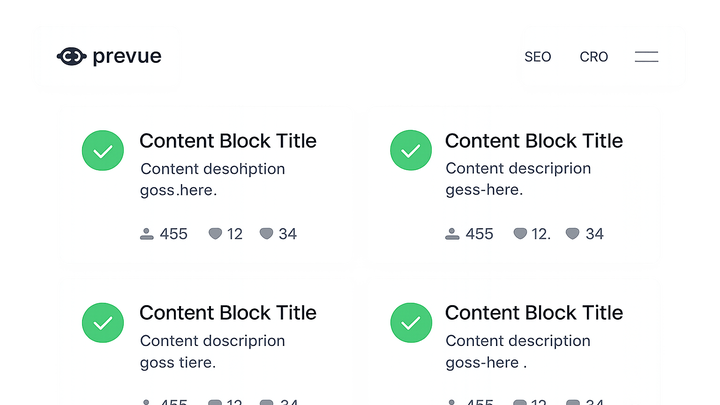Published on 2025-06-29T19:59:04Z
What is Content Relevance? Examples and Impact on CRO/UX/SEO
Content Relevance refers to the degree to which website content aligns with the needs, expectations, and intent of target users. In the context of CRO, UX, and SEO, it plays a pivotal role in determining how effectively a page engages visitors and satisfies search queries. When content is highly relevant, users are more likely to stay on the page, explore further, and complete desired actions, boosting both engagement and conversion rates. From an SEO perspective, search engines use sophisticated algorithms to evaluate topical relevance, rewarding pages that best answer user intent. In UX, delivering contextually relevant information at the right moment enhances the overall experience, reducing friction and frustration. Tools like Prevue.me can help website owners by providing actionable critiques to identify gaps in content relevance and drive maximum lead generation.
Content relevance
Content relevance ensures website content aligns with user intent, boosting engagement, SEO rankings, and conversions.
Why Content Relevance Matters
Understanding the importance of content relevance helps prioritize efforts that directly impact user satisfaction, search rankings, and conversion outcomes.
-
Boosting user engagement
Content that closely matches user needs and questions encourages visitors to explore more pages, spend longer sessions, and interact with CTAs.
-
Enhancing seo performance
Search engines analyze whether a page truly answers a query. Highly relevant content is more likely to rank higher and attract qualified traffic.
-
Improving conversion rates
When users find exactly what they’re looking for, they’re more inclined to take desired actions—signing up, downloading, or purchasing.
Key Metrics for Measuring Content Relevance
Quantitative and qualitative metrics reveal how well your content resonates with audience expectations and search intent.
-
Bounce rate
A lower bounce rate often indicates that visitors found content relevant enough to stay rather than leave immediately.
-
Dwell time
Longer average time on page suggests that users are engaging with and absorbing the content.
-
Semantic relevance score
Tools like prevue.me analyze keyword usage and topic coverage to assign a relevance score against target intents.
-
Engagement signals
Behavioral cues such as how far users scroll or which elements they click show real-time interest.
- Scroll depth:
Measures the percentage of the page a user scrolls through, indicating content value.
- Click patterns:
Heatmaps reveal which links, buttons, or sections users interact with most.
- Scroll depth:
Best Practices to Optimize Content Relevance
Implementing proven strategies ensures your material stays focused, useful, and aligned with evolving user needs.
-
Audience research & persona alignment
Develop detailed user personas and validate them through surveys and analytics to tailor content precisely.
- User surveys:
Collect direct feedback on user goals, pain points, and preferred formats.
- User surveys:
-
Semantic seo & keyword mapping
Organize topics into clusters and map primary and LSI keywords to ensure depth and context.
-
Content structure & readability
Use clear headings, bullet points, and concise paragraphs to help users and search engines parse relevance.
- Headings and subheadings:
Guide readers through logical topic progression.
- Bullet points and lists:
Break down complex ideas for quick scanning.
- Headings and subheadings:
-
Continuous testing & feedback
Iterate content based on A/B tests, heatmaps, and user testing to refine relevance over time.
- A/b testing:
Compare content variations to see which aligns best with user intent.
- User testing:
Observe real users navigating your content for qualitative insights.
- A/b testing:
Example: Using Prevue.me to Enhance Content Relevance
prevue.me leverages AI to audit your site’s content against user intent and SEO best practices, delivering prioritized recommendations.
-
Automated content audits
Scans pages for gaps in topic coverage, keyword usage, and alignment with target personas.
-
Actionable insight reports
Generates clear, prioritized tasks—like adding FAQs or adjusting headings—to boost relevance.
-
Integrating recommendations into workflow
Exports findings directly to your CMS or project management tools, streamlining implementation.
